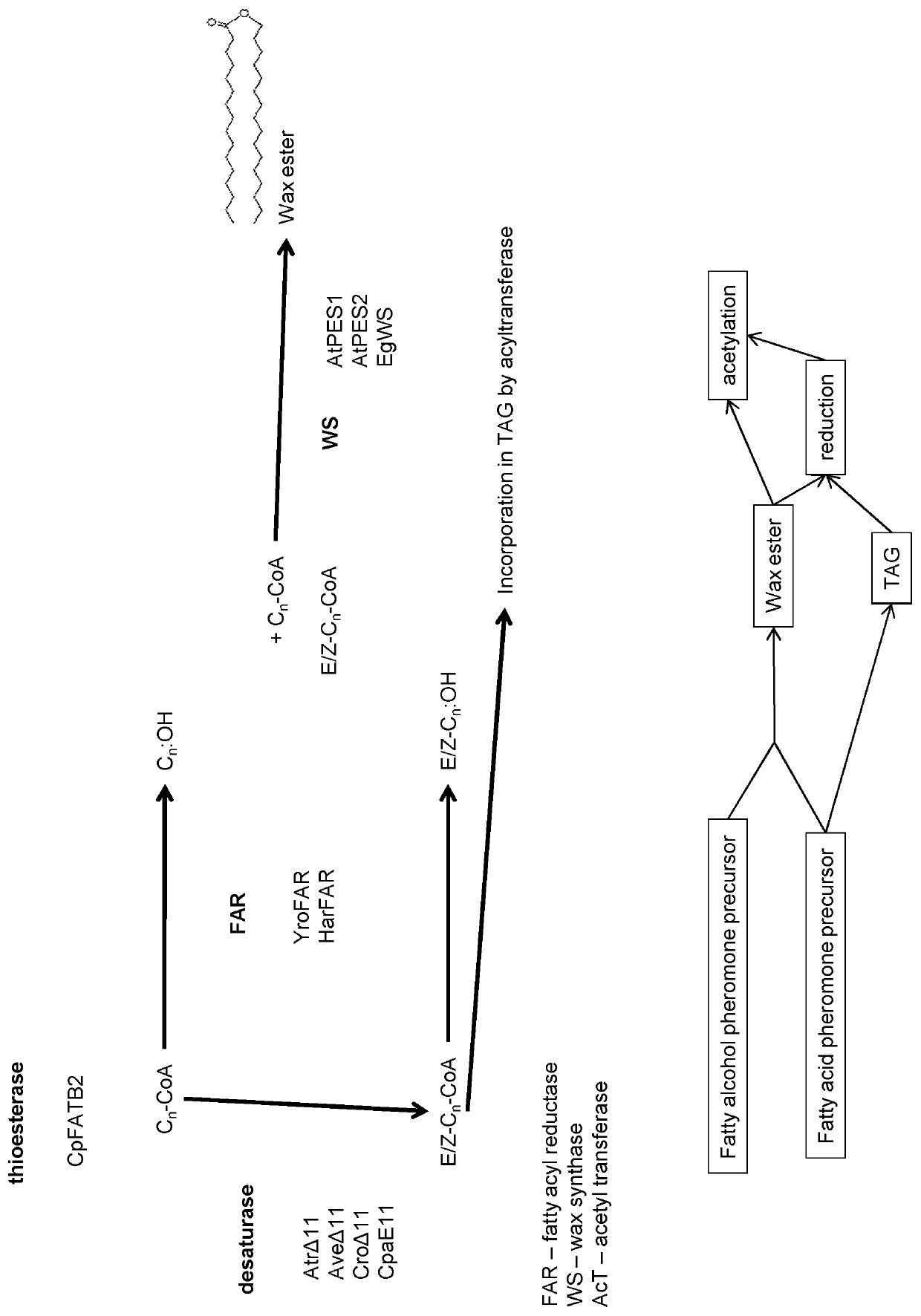Production of insect pheromone precursors in plants
a technology of pheromones and plants, applied in biochemistry apparatus and processes, organic chemistry, fermentation, etc., can solve the problems of high labor costs for the application of pheromones, and achieve the effect of limiting the use of chemical reactions and cheap and more benign chemistry
- Summary
- Abstract
- Description
- Claims
- Application Information
AI Technical Summary
Benefits of technology
Problems solved by technology
Method used
Image
Examples
example 1
[0049]Production of Insect Pheromone Precursors as Constituents of Wax Esters (WE)
[0050]For precursor production as constituents of wax ester in seed oil, genes coding for Cuphea palustris plastidic acyl-ACP thioesterase (CpFATB2), Argyrotaenia velutinana desaturase (AveΔ11), Amyelois transitella desaturase (AtrΔ11), Helicoverpa armigera fatty acyl reductase (HarFAR) and the mature form of Arabidopsis thaliana phytol ester synthase 2 lacking plastid transit peptide sequence (mAtPES2) were respectively cloned between a glycinin or napin promoter and a glycinin or nopaline synthase terminator. The genes fused to glycinin or napin promoter and glycinin or nopaline synthase terminator were inserted between T-DNA right and left border sequences of a binary vector where also an nptII gene for selection of transgenic cells was situated. Camelina sativa plants were transformed using floral dipping and produced seeds germinated on kanamycin containing medium. Transformed plants were selfed a...
example 2
[0052]Production of Desaturated Insect Pheromone Precursors as Constituent of Triacylglycerols (TAG).
[0053]For precursor production as constituents of triacylglycerol (TAG) in seed oil, genes coding for Cuphea palustris plastidic acyl-ACP thioesterase (CpFATB2), Choristoneura parallela desaturase (CpaE11), Argyrotaenia velutinana desaturase (AveΔ11), Amyelois transitella desaturase (AtrΔ11) were respectively cloned between a glycinin or napin promoter and a glycinin or nopaline synthase terminator. The genes fused to glycinin or napin promoter and glycinin or nopaline synthase terminator were inserted between T-DNA right and left border sequences of a binary vector where also an nptII gene for selection of transgenic cells was situated. Camelina sativa plants were transformed using floral dipping and produced seeds germinated on kanamycin containing medium. Transformed plants were selfed and seeds collected upon maturation. Lipids were extracted from seeds and then separated using t...
example 3
[0055]The production of active pheromone from TAG (triacylglycerols) containing precursor pheromone fatty acids was performed by fractionation and chemical conversion procedures. The oil was treated with water free methanol containing acid or alkali as catalysts to yield fatty acid methyl esters. The fatty acid of interest was purified as methyl esters by short path distillation or by crystallization and the fatty acid was converted to corresponding fatty acid alcohol by reaction with lithiumaluminium hydride or tri-tert-butoxyaluminumlithium hydride or by selective catalytic hydrogenation by high pressure hydrogenation. Resulting fatty alcohol was acetylated by treatment with acetylchloride or acetic acid anhydride to yield the final active pheromone molecule.
PUM
| Property | Measurement | Unit |
|---|---|---|
| fresh weight | aaaaa | aaaaa |
| fresh weight | aaaaa | aaaaa |
| fresh weight | aaaaa | aaaaa |
Abstract
Description
Claims
Application Information
 Login to View More
Login to View More - R&D
- Intellectual Property
- Life Sciences
- Materials
- Tech Scout
- Unparalleled Data Quality
- Higher Quality Content
- 60% Fewer Hallucinations
Browse by: Latest US Patents, China's latest patents, Technical Efficacy Thesaurus, Application Domain, Technology Topic, Popular Technical Reports.
© 2025 PatSnap. All rights reserved.Legal|Privacy policy|Modern Slavery Act Transparency Statement|Sitemap|About US| Contact US: help@patsnap.com

